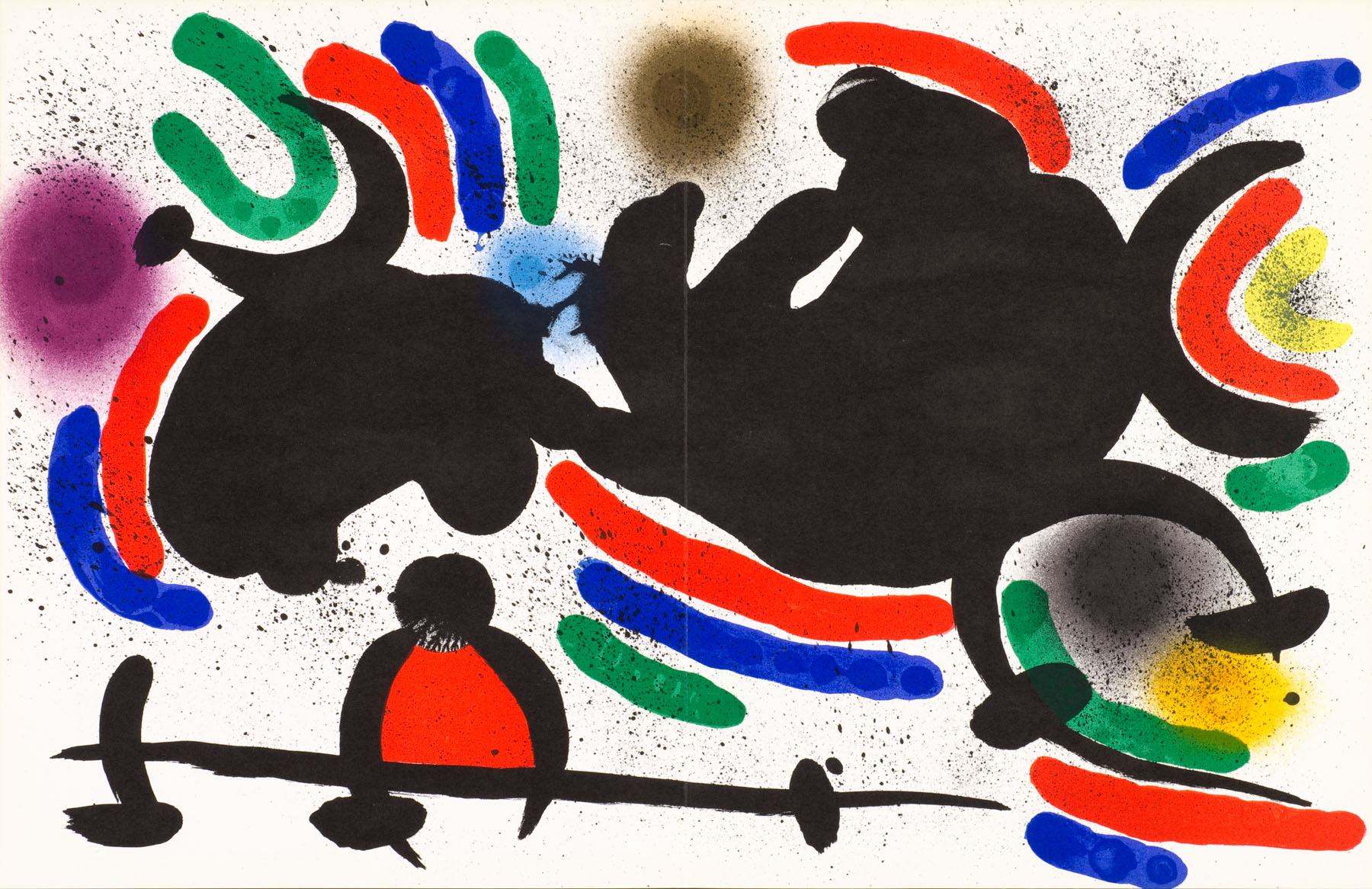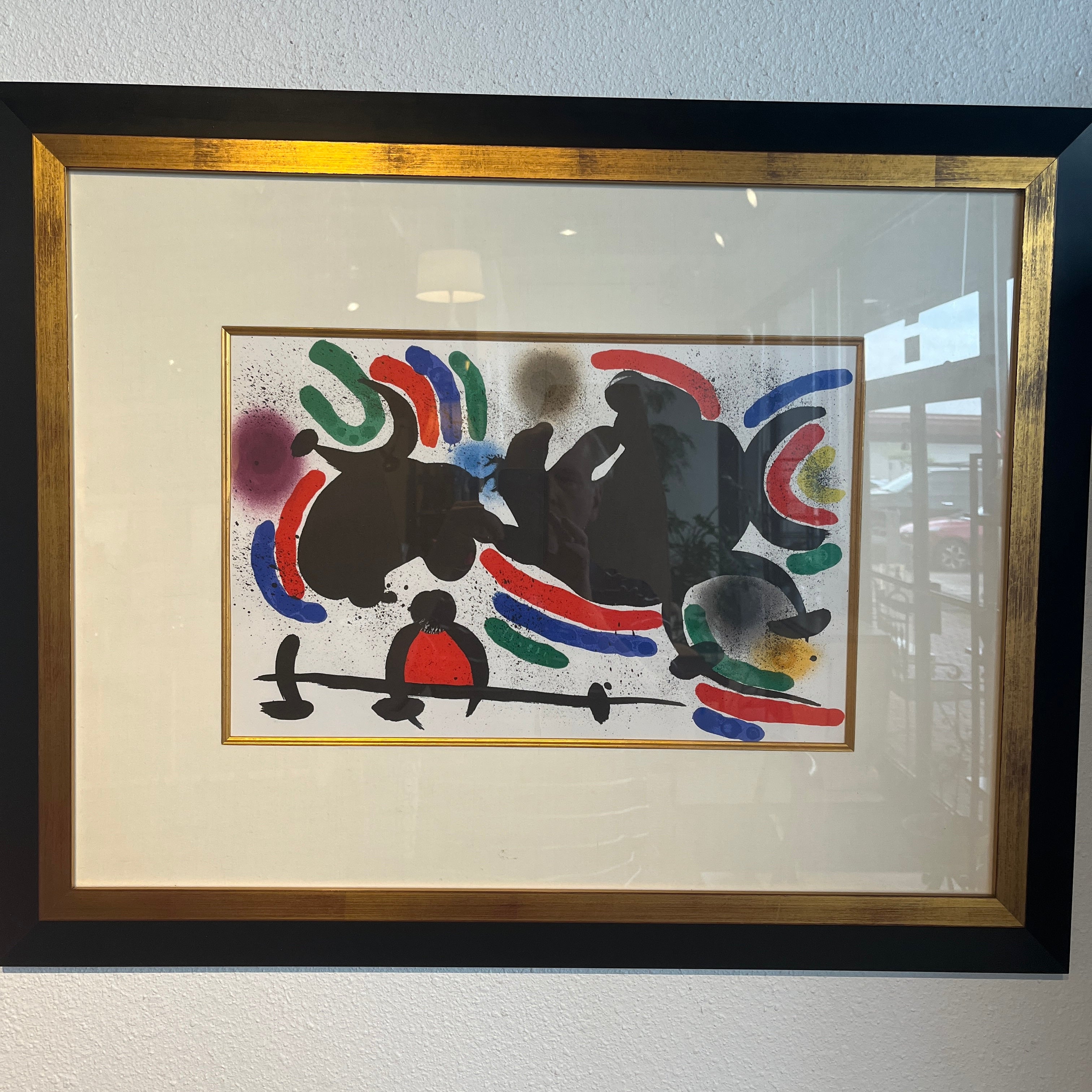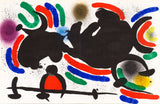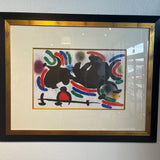

‘LITHOGRAPHE I - PLATE IV’ BY JOAN MIRÓ (1972)
CONTACT US HERE ABOUT THIS ITEM.
Two of eleven plates realized by JOAN MIRÓ (1893–1983) for Volume I of his 1972 Catalogue Raisonné of lithographs (published by Graphis Arte, Livorno, and Toninelli Arte Moderna, Milano)—each a vibrant dance of whimsy and the subconscious. Famously eschewing academic theory, Miró’s creative approach involved the free play of association—provoking “accidents” connected to the inner workings of his psyche. Hence, the poet André Breton (1896–1966) called him “the most Surrealist of us all.” The sense of cheerful playfulness is integral to his enduring popularity. Priced individually and accompanied by Gallery COAs.
JOAN MIRÓ I FERRÀ is regarded as one of the 20th century’s most original artists. He struck a balance—between spontaneity and automatism on the one hand and meticulous planning and rendering on the other—which makes his work, because of its precision, seem somehow representational, despite its considerable abstraction. His mature style arose out of the tension between the brutalities of modern life and his personal poetic impulses.
Born into a family of artisans in Barcelona, the renowned Catalan painter and sculptor showed a teenage interest in drawing, and in 1907 took lessons at the city’s Escola Superior d’Arts Industrials i Belles Arts. At his father’s insistence, he simultaneously enrolled at the Escola de Comerç to study business. After three years of classes, he found work as an accounts clerk in a chemist’s shop. Stressed to the point of exhaustion, he collapsed with a nervous breakdown, and, after an ensuing bout of typhoid, was taken to live at his parents’ farm in Mont-roig del Camp, a secluded seaside village, 125 km to the southeast. During his convalescence, he foreswore business entirely, and in 1912 he resumed the study of art at the Barcelona school run by painter Francesc d'Assís Galí (1880—1965). The following year, he enrolled in life classes at the Cercle Artístic de Sant Lluc.
In 1916, Miró met the Symbolist painter and art dealer Josep Dalmau (1867—1937), who managed the revolutionary Galeries Dalmau in Barcelona. Intrigued by Miró’s talents, Dalmau offered to host a solo exhibition for him in 1918. Sadly it was a disaster; critics and the public alike ridiculed and even damaged the paintings. Undeterred, Miró traveled to Paris for the first time in 1920 and would go on to spend the decade alternating between the French capital and Mont-roig.
The next year Dalmau organized a show for Miró at Paris’s Galerie La Licorne. There he met Pablo Picasso (1881—1973); André Masson (1896—1987) as well as a dozen other Surrealist luminaries; and such notable American ex-pats as Ezra Pound (1885—1972) and Ernest Hemingway (1899—1961)—the latter would purchase The Farm, a landscape of the artist's family home in Mont-roig.) While Miró’s work from the early 1920s reflected the influence of Cubism, over the decade his distinctive style of flattened picture planes, organic forms, and linear symbols developed. In 1925, he met André Breton (1896—1966), the principal theorist of Surrealism, and had his first solo exhibition the surrealist Galerie Pierre. The following year, he collaborated with Max Ernst (1891—1976) on designs for Diaghilev’s Ballets Russes.
Miró was the subject of a retrospective at MoMA in New York, in 1941. He won the Grand Prize for Graphic Work at the XXVII Venice Biennale in 1954, and featured in the inaugural Documenta in Kassel, Germany, the following year. In 1958, he was given a Guggenheim International Award for murals he executed for the UNESCO building in Paris. Further retrospectives took place in Paris at the Musée National d’Art Moderne, in 1962, and the Grand Palais, in 1974; in 1978 the Musée National d’Art Moderne exhibited more than five hundred works in a retrospective of his drawings.
Miró died in 1983, in Palma de Mallorca, Spain, in the western Mediterranean.
NOTABLE WORKS:
- The Farm, 1922
- The Tilled Field, 1924
- The Hunter (Catalan Landscape), 1924
- Harlequin’s Carnival, 1925
- Painting (Blue Star), 1927
- Dutch Interior I, 1928
- The Escape Ladder, 1940
- Woman and Birds in the Night, 1945
- The Smile of the Flamboyant Wings, 1953
- The Gold of the Azure, 1993
I try to apply colours like words that shape poems, like notes that shape music. – JOAN MIRÓ
DETAILS
Artist – JOAN MIRÓ (1893—1983)
Period/Year – 1972
Origin – SPAIN
Styles/Movements – ABSTRACT; SURREALISM
Media – LITHOGRAPHY
Support – PAPER
Edition – EDITION
Colors – BLACK, RED, BLUE, GREEN, YELLOW
Condition – Excellent vintage condition. May show minor signs of previous ownership and use.
Dimensions – 27" H × 34" W × 1" D


